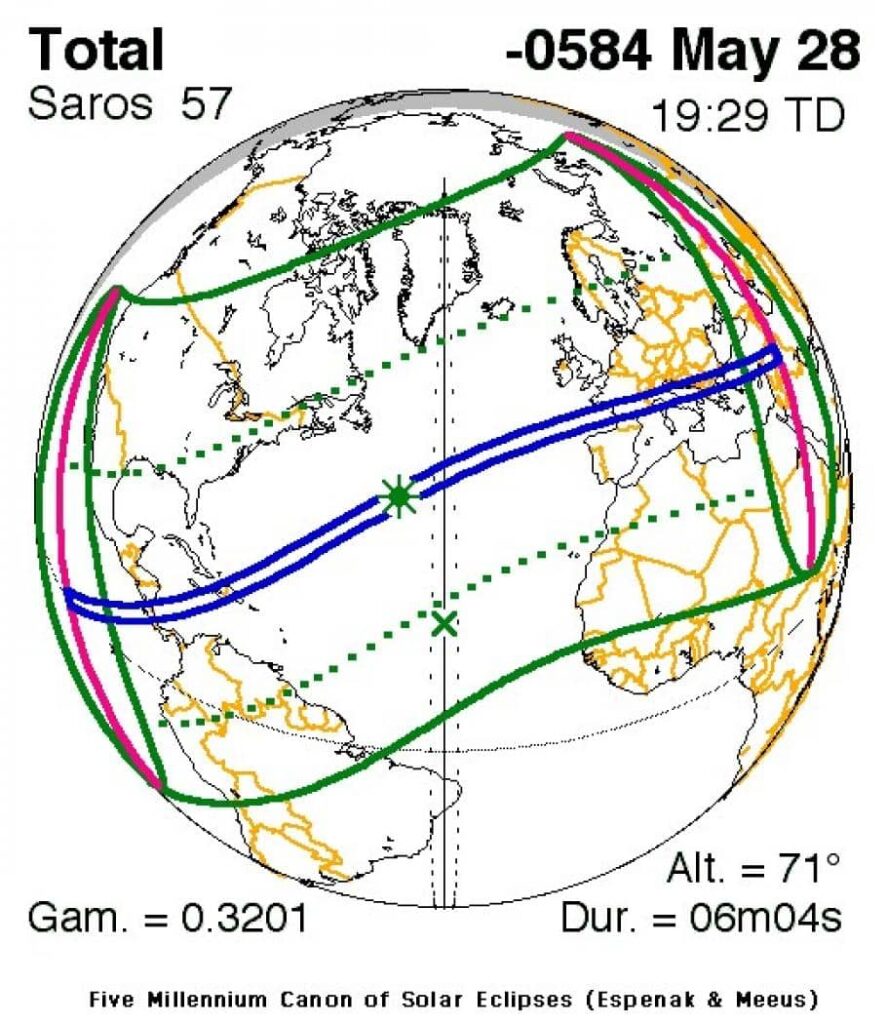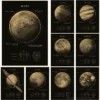This Content Is Only For Subscribers
Updated 2025
Imagine two ancient armies locked in fierce combat when suddenly the sky darkens. Day transforms into night, stars appear at noon, and terrified soldiers drop their weapons. This extraordinary scene unfolded on May 28, 585 BCE, when a total solar eclipse interrupted the Battle of Halys between the Median and Lydian empires. The cosmic intervention ended a five-year war and created one of history’s most dramatic peace treaties.
Two Superpowers Collide: Medes vs. Lydians
In the early 6th century BCE, two formidable kingdoms dominated the Near East. The Medes, an Iranian people led by King Cyaxares, had helped topple the mighty Assyrian Empire and controlled territories from modern Iran westward into Anatolia. The Lydians, ruled by King Alyattes from their capital at Sardis, governed a wealthy realm in western Anatolia famous for its gold deposits and early coinage.
Why the Halys River Became a Flashpoint
As the Lydians expanded eastward and the Medes pushed west, these rival powers inevitably clashed along the Halys River (modern Kızılırmak in Turkey). This waterway served as a natural boundary between their spheres of influence, becoming the flashpoint for territorial disputes.
Herodotus’ Tale of Scythian Hunters & Diplomatic Insult
The Greek historian Herodotus recounts a dramatic catalyst for the conflict. A group of Scythian hunters, guests at Cyaxares’ court, gravely insulted their host by killing one of his children. The hunters fled west, seeking asylum with King Alyattes. When Cyaxares demanded their extradition and Alyattes refused, war erupted between the kingdoms.
“Day was on a sudden changed into night.” — Herodotus 1.74
For five years, the Medes and Lydians fought an inconclusive war. Neither side gained decisive advantage despite several battles, including one reportedly fought at night. The conflict drained both empires until fate – or astronomy – intervened.

May 28, 585 BCE: Darkness at Noon on the Halys
As armies clashed near the Halys River on that spring afternoon, the battle “was growing warm” when an extraordinary event silenced the fighting. The sun began to disappear, gradually covered by the moon’s shadow. Daylight faded until stars appeared in the midday sky.
Herodotus writes that when “day was on a sudden changed into night,” the warring armies interpreted this celestial phenomenon as a divine omen commanding peace. Soldiers laid down their weapons as commanders from both sides, equally stunned by the cosmic spectacle, halted combat operations.
Modern astronomers have precisely calculated this event as a total solar eclipse that crossed Anatolia on May 28, 585 BCE. The eclipse’s path of totality swept through southwestern Turkey in the late afternoon, creating near-total darkness in the battle region. For the ancient warriors, this sudden blackening of the sun represented an unmistakable message from the gods.

The Peace Treaty: Royal Marriage and a New Border
The eclipse created an immediate opportunity for peace negotiations. Both kings, shaken by the apparent divine intervention, quickly moved to end hostilities with the help of neutral mediators. King Nebuchadnezzar II of Babylon and King Syennesis of Cilicia facilitated discussions between the rival powers.
The terms of peace featured two key elements. First, both sides agreed to establish the Halys River as the permanent boundary between their kingdoms, defining their respective territories. Second, they sealed their alliance through a royal marriage – Alyattes gave his daughter, Princess Aryenis of Lydia, in marriage to Prince Astyages, son of Cyaxares.
This diplomatic resolution established a balance of power that lasted for decades, until Persian king Cyrus the Great eventually conquered both kingdoms. The eclipse-inspired peace maintained stability in the Near East during a crucial historical period.

Did Thales Really Predict the Eclipse?
One of the most fascinating aspects of this story involves Thales of Miletus, a Greek philosopher and astronomer. Herodotus claims Thales “forewarned the Ionians” about the eclipse, predicting “the very year” it would occur. If true, this would represent history’s first recorded scientific prediction of a solar eclipse.
Modern scholars, however, question whether Thales could have made such a precise forecast. The astronomical knowledge of his time lacked the mathematical tools to predict exactly when and where a solar eclipse would occur. While Babylonian astronomers had identified certain eclipse cycles, they could not reliably predict solar eclipses for specific locations.
More likely, Thales understood basic eclipse patterns, perhaps based on Babylonian astronomical knowledge of the Saros cycle (the 18-year pattern of eclipse recurrence). He might have made a general prediction that an eclipse could happen sometime that year. When it dramatically coincided with the battle, his reputation soared, and later generations credited him with a more precise prediction than possible at the time.

Despite these scholarly doubts, the story of Thales’ prediction became legendary. Isaac Asimov called the Battle of the Eclipse “the birth of science” and “the earliest historical event whose date is known to the day.” The Smithsonian Magazine notes that while precise prediction was impossible, Thales’ general forecast represents an early triumph of observation-based thinking over pure superstition.
Fact-Checking the Ancient Sources
How reliable is this captivating story? Herodotus wrote his account roughly 150 years after the event, based on oral traditions and earlier sources now lost. While historians generally find his narrative plausible, some details may have been dramatized.
Herodotus doesn’t specify the battle’s exact location, though tradition places it near the Halys River. Other ancient writers like Cicero and Pliny the Elder corroborate elements of the story, particularly Thales’ prediction. Their references suggest the eclipse battle became firmly established in ancient historical consciousness.

Most compellingly, modern astronomical calculations confirm a total solar eclipse crossed Anatolia on May 28, 585 BCE – exactly when Herodotus places the battle. This scientific verification lends considerable credibility to the core narrative, even if certain details may have been embellished over time.
Legacy: The First Precisely Dated Historical Event
The Battle of the Eclipse stands as a rare moment where cosmic and human history intersect with unusual precision. Its significance extends beyond the immediate peace treaty to several broader impacts:
- Chronological anchor point: The eclipse provides a fixed date that helps historians establish the timeline of ancient Near Eastern history.
- Scientific milestone: Whether or not Thales predicted it accurately, the eclipse marked an early attempt to understand celestial phenomena through observation rather than pure mythology.
- Geopolitical influence: The peace treaty shaped the regional balance of power, establishing boundaries and alliances that defined the Near East until Persia’s rise.
When modern tourists visit Turkey’s Kızılırmak River, few realize they stand where darkness once stopped a war and where ancient kings established peace under a blackened sky. The Battle of the Eclipse remains a powerful reminder that sometimes the cosmos itself seems to intervene in human affairs.
FAQ: Common Questions About the Battle of the Eclipse
What is the Battle of the Eclipse? A clash between the Medes and Lydians that ended abruptly when a total solar eclipse darkened the battlefield on May 28, 585 BCE.
Who fought in the battle? King Alyattes of Lydia and King Cyaxares of Media, near the Halys (Kızılırmak) River in Anatolia.
How did the eclipse stop the war? Soldiers interpreted the sudden darkness as a divine omen; leaders rushed to negotiate peace and sealed it with a royal marriage.
Did Thales of Miletus predict the eclipse? Ancient sources say yes, but modern scholars doubt he could forecast the exact date—he likely made a broad cyclical prediction.
Why is the event historically important? Astronomers can date the eclipse precisely, giving historians a fixed point in early Near-Eastern chronology and highlighting early scientific thought.



